Discovering the Secrets of Stoicism in Modern Athens

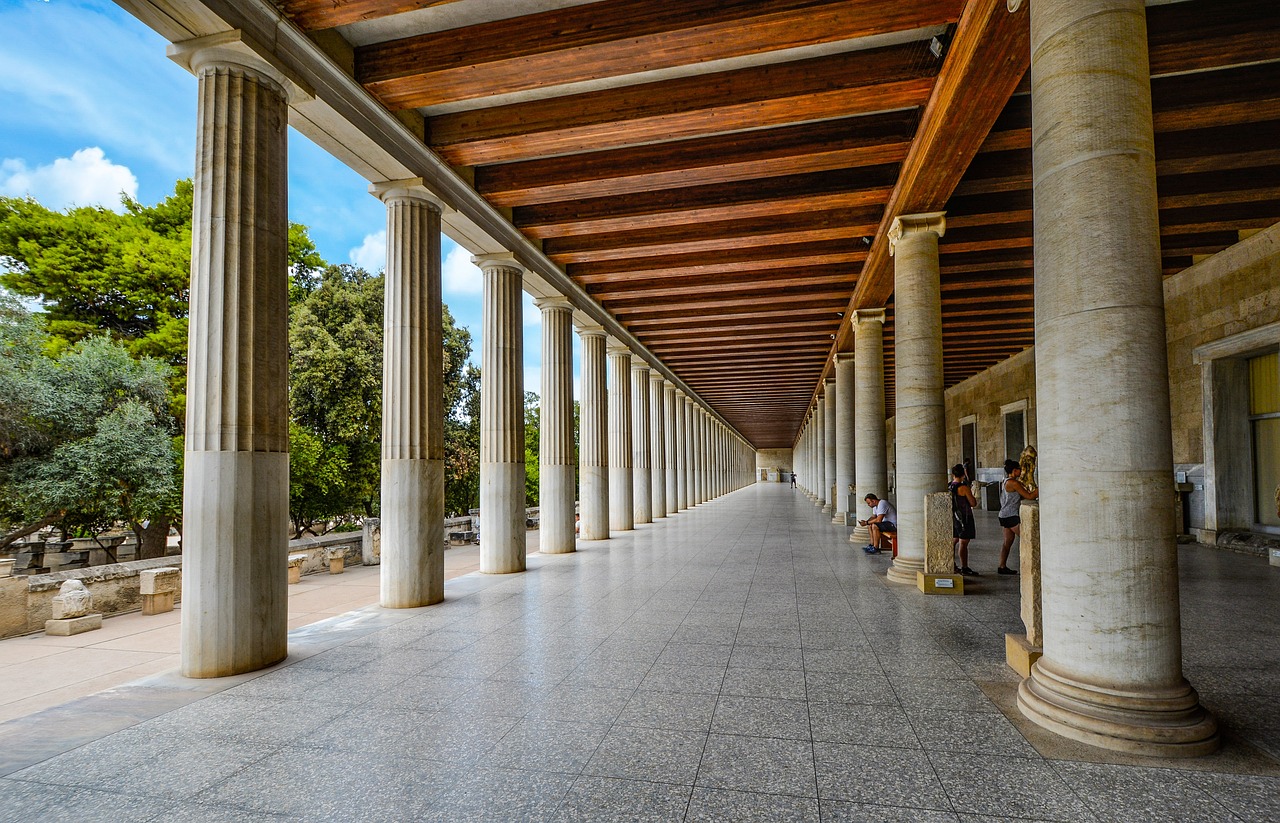
Stoa Poikile (Painted Porch)
The Stoa Poikile, one of Athens’ most renowned structures, earned its name from the exquisite panel paintings that once adorned its walls. These masterpieces, created by some of the finest artists of Classical Greece, were installed around the mid-5th century B.C. Even 600 years later, around A.D. 150, the traveler Pausanias could still describe four of these paintings, which celebrated Athenian military victories, both mythological and historical. The most famous among these was likely the depiction of the Battle of Marathon (490 B.C.) by Polygnotos. However, by A.D. 400, these artworks had vanished, reportedly removed by a Roman proconsul. In addition to the artwork, the Stoa once displayed actual weapons and armor from defeated enemies, serving as a stark reminder to Athenians of their former glory.
Unlike many other structures in the Agora, the Stoa Poikile was a truly public building, used informally by a mixed throng of people, not dominated by any particular official, group, or function. Among those who came regularly were the philosophers, who could expect to find an audience ready to listen to them. Among these thinkers, Zeno of Citium stands out as the founder of the Stoic school of philosophy. Around 300 B.C., Zeno arrived in Athens from Cyprus and chose the Painted Stoa as his preferred location for teaching, so much so that his followers took their name from this very spot.
Today, only the foundations and a few scattered architectural fragments remain of the original stoa. However, the site still holds great significance for Stoic pilgrims. The stoa’s location in the bustling Agora marketplace reflects the Stoic belief in teaching philosophy publicly, in contrast to other schools located in private gymnasia.
How did the Stoa Poikile looked like?
The Stoa Poikile, one of the major classical structures in the Athenian Agora, stands as a testament to the architectural prowess of ancient Athens. The excavation of this site has revealed a building of considerable size and prominence, evidenced by its massive foundations and high-quality construction. The stoa’s orientation, with its long axis running northeast to southwest, placed its principal façade facing southward onto the Agora, a strategic positioning that underscored its significance.
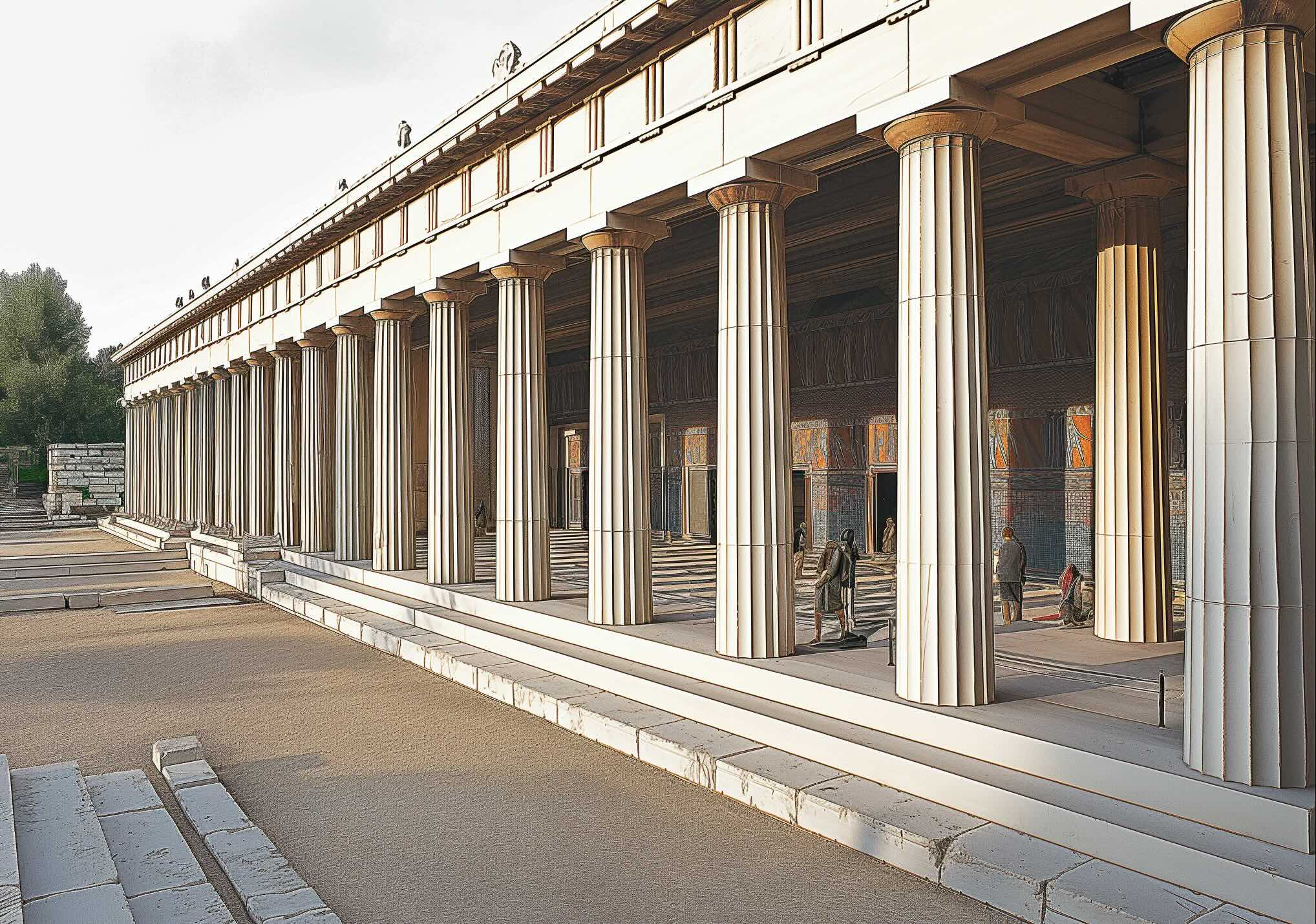
Architecturally, the Stoa Poikile featured a combination of Doric and Ionic orders, with a meticulous use of poros stone in its construction. The foundations display precise architectural details, such as well-worn steps and carefully placed blocks with tight joints, indicating the building’s importance in the classical period. These details suggest that the stoa was not just a functional structure but also a symbol of Athenian craftsmanship and cultural pride.
Why Stoa Poikile was important?
Beyond its architectural grandeur, the Stoa Poikile was a cultural and philosophical landmark in Athens. It is famously known as the site where Zeno of Citium founded the Stoic school of philosophy. The stoa’s walls were adorned with renowned paintings depicting historical and mythological scenes, including the Battle of Marathon. These artistic representations were not merely decorative; they served as visual embodiments of Athenian valor and played a significant role in shaping the collective memory and identity of the city.
The construction of the Stoa Poikile is dated to the second quarter of the 5th century BCE, supported by both archaeological evidence and historical records. Pottery fragments discovered beneath the stoa’s foundations suggest that the building was erected between 470-460 BCE. The stoa remained a prominent feature of the Agora for centuries, continuing to be utilized until at least the 5th century CE, when a late Roman colonnade was added to its western side.
Late Roman Adaptations and the Stoa’s End
During the late Roman period, the Stoa Poikile witnessed significant changes. A new street colonnade was constructed to the west of the stoa, indicating the building’s continued importance in the Agora. The foundations of this colonnade were aligned with the corner anta of the stoa, suggesting that the structure was still standing and in use during this time. The integration of the colonnade with the stoa’s existing foundations, along with the presence of late Roman pottery, highlights the adaptive reuse of this iconic building as the city evolved.
However, the glory of the Stoa Poikile was not to last forever. In the 6th century CE, the building was systematically demolished, likely due to the broader decline of the Agora and Athens itself. The stoa was extensively quarried for stone, with its blocks removed down to the euthynteria (the topmost course of the building’s foundation). Interestingly, parts of the western steps were protected by the late Roman colonnade, preserving a fragment of the stoa’s legacy even as the rest of the structure was lost to time.
The story of the Stoa Poikile, from its architectural brilliance to its role as a philosophical hub and its eventual decline, offers a profound insight into the cultural and historical evolution of Athens. It stands as a reminder of the city’s rich past and the layers of history that continue to be uncovered through ongoing archaeological research.
Ancient Agora
The Ancient Agora of Athens, where the Stoa Poikile stood, is an important archaeological site for understanding the context of early Stoicism. It was the commercial, social, and political center of ancient Athens. Philosophers like Socrates would engage in discussions with craftsmen and citizens in the Agora, influencing the public nature of Stoic teaching.
While the Agora is in ruins today, visitors can still explore the foundations of shops, wells, and other structures that would have surrounded the Stoa Poikile in Zeno’s time. The site provides a glimpse into the vibrant setting where Stoicism first took root.
For example, one can visit the reconstructed Stoa of Attalos, which gives a sense of what the Stoa Poikile might have looked like in its prime. Although less famous than the Acropolis, the Agora is where the real intellectual action happened. It’s a must-visit for anyone wanting to understand the social and philosophical fabric of ancient Athens.
Is More of the Stoa Poikile About to Come to Light?
Yes! There are new developments. The American School of Classical Studies in Athens continues its excavations of the Stoa Poikile in the Ancient Agora after the recent demolition of a building at 14 Agios Philippou Street, which had previously obstructed the site.
The demolition, following a decade-long process of declassification and expropriation, has allowed archaeologists to explore the northeastern part of the Stoa, which has remained uncovered. The ongoing excavations involve the American School in collaboration with the Ephorate of Antiquities of Athens City, and include student volunteers.
The excavations are part of a broader effort to reveal hidden parts of the Ancient Agora while preserving any Byzantine structures found in the process. The project is expected to transform the local neighborhood, providing new vistas and historical insights.
Connecting the Dots: The Stoic Legacy in Modern Athens
Visiting these ancient sites isn’t just about ticking off boxes on a tourist itinerary. It’s about connecting with a philosophical tradition that has endured for millennia. The Stoics believed in the power of reason, the importance of virtue, and the acceptance of things beyond our control—principles that are as relevant today as they were 2,000 years ago. By walking the same paths as Zeno and Chrysippus, you’re not just learning about history; you’re participating in it.
Exploring Stoic Athens: Self-Guided and Guided Tours
Self-Guided Tours
If you prefer exploring at your own pace, two self-guided tours at the Ancient Agora are perfect for immersing yourself in the world of Stoic philosophy.
- The Stoa Poikile (Painted Stoa)
- Location: Ancient Agora of Athens
- Highlights: This site, once adorned with famous paintings, was where Zeno of Citium taught, giving birth to the Stoic philosophy. Walking through the remains of the Stoa Poikile, you can almost hear the echoes of philosophical debates that once took place here.
- What to Bring: A guidebook or a reliable audio guide will enhance your understanding of the site’s significance.
- The Stoa of Attalos
- Location: Ancient Agora of Athens
- Highlights: Reconstructed to its former glory, this stoa houses the Museum of the Ancient Agora. It offers a glimpse into the daily life of ancient Athenians and the marketplace where Stoic ideas were discussed and disseminated.
- What to Bring: A notebook to jot down your reflections or any thoughts inspired by the artifacts and exhibits.
Guided Tours
For a more in-depth experience, consider joining one of these guided tours that will lead you through Athens’ rich philosophical heritage, including its Stoic roots.
- The Path to Democracy: Acropolis & Agora Tour
- Duration: 3 hours
- Overview: This tour explores the birth of democracy, closely linked to the philosophical movements that flourished in Athens, including Stoicism. You’ll visit the Acropolis and the Ancient Agora, with stops at significant sites like the Temple of Hephaestus, where you can contemplate the relationship between Stoic ideals and the democratic principles that shaped Athens.
- Athens Highlights: Myths & Philosophers Private Walking Tour
- Duration: 4 hours
- Overview: This private tour takes you on a journey through Athens’ intellectual past, focusing on both mythology and philosophy. You’ll walk the same paths as Socrates, Plato, and Zeno, gaining insights into the philosophical discussions that still influence modern thought.
The Ultimate Tour: Acropolis and 6 Archaeological Sites Combo Ticket
This combo ticket is your key to unlocking the philosophical landscape of Athens. With access to seven of the city’s most significant archaeological sites, including the Ancient Agora where Stoicism was born, you can explore the context in which Stoic ideas were developed and debated. The ticket’s flexibility allows you to visit these historic sites over five days, giving you the time to reflect on their significance as you move from one to the next.
What’s Included:
- Acropolis: Begin at the Acropolis, the heart of ancient Athens, and consider how the values of endurance and reason were reflected in the city’s most iconic structures.
- Ancient Agora: Walk through the Stoa Poikile, where Zeno taught, and let the philosophical origins of Stoicism resonate as you explore.
- Roman Agora and Beyond: Continue your journey through sites like the Roman Agora and the Temple of Olympian Zeus, each offering a unique glimpse into the world that shaped Stoic thought.
FAQ: Stoicism in Modern Athens
What is the Stoic school in Athens?
The Stoic school in Athens, known as the Stoa Poikile (Painted Porch), was where Zeno of Citium, the founder of Stoicism, taught his philosophy. It was located in the Ancient Agora of Athens and was a hub for philosophical discussion and teaching. Today, while the original Stoa Poikile no longer stands, the site remains a significant point of interest for those exploring the roots of Stoic philosophy.
Is Stoicism relevant in modern society?
Absolutely. Stoicism has seen a resurgence in recent years, particularly among those seeking practical guidance for dealing with life’s challenges. Its principles of resilience, rationality, and emotional control resonate with modern audiences, making it as relevant today as it was in ancient times.
What are the four virtues of Stoicism in Greek?
The four cardinal virtues of Stoicism are wisdom (σοφία, sophia), courage (ἀνδρεία, andreia), justice (δικαιοσύνη, dikaiosyne), and temperance (σωφροσύνη, sophrosyne). These virtues are considered essential for leading a good and fulfilling life.
Who are the big 3 Stoic philosophers?
The three most prominent Stoic philosophers are Zeno of Citium, who founded Stoicism; Seneca the Younger, a Roman philosopher and statesman; and Marcus Aurelius, a Roman Emperor whose writings, known as the “Meditations,” are considered a key Stoic text.
Why did Stoicism gain popularity again?
Stoicism has gained popularity in recent years due to its practical and accessible approach to dealing with everyday challenges. Its emphasis on inner peace, resilience, and rational thinking makes it appealing in today’s fast-paced and often stressful world. The teachings of Stoicism provide timeless advice on how to live a meaningful and contented life, which has resonated with modern audiences, particularly through the work of contemporary authors and influencers who advocate for Stoic principles.
What is the difference between traditional Stoicism and modern Stoicism?
Traditional Stoicism, as taught in ancient Athens, emphasized living in accordance with nature, rationality, and virtue as the path to a good life. Modern Stoicism adapts these principles to contemporary life, often focusing on psychological resilience, personal development, and mindfulness. While the core ideas remain the same, modern Stoicism is often more flexible and accessible to a broader audience.
How to be Stoic in modern times?
Being Stoic in modern times involves practicing self-control, focusing on what you can control, and maintaining a rational perspective in the face of adversity. This can be achieved through regular reflection, mindfulness, and the application of Stoic exercises, such as negative visualization and journaling.

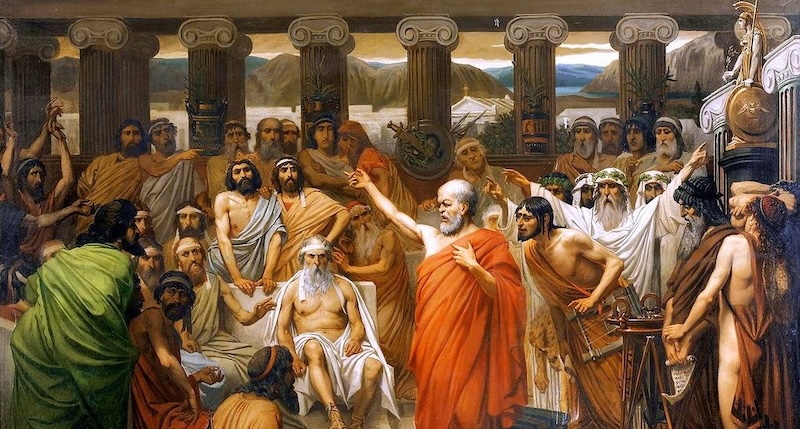
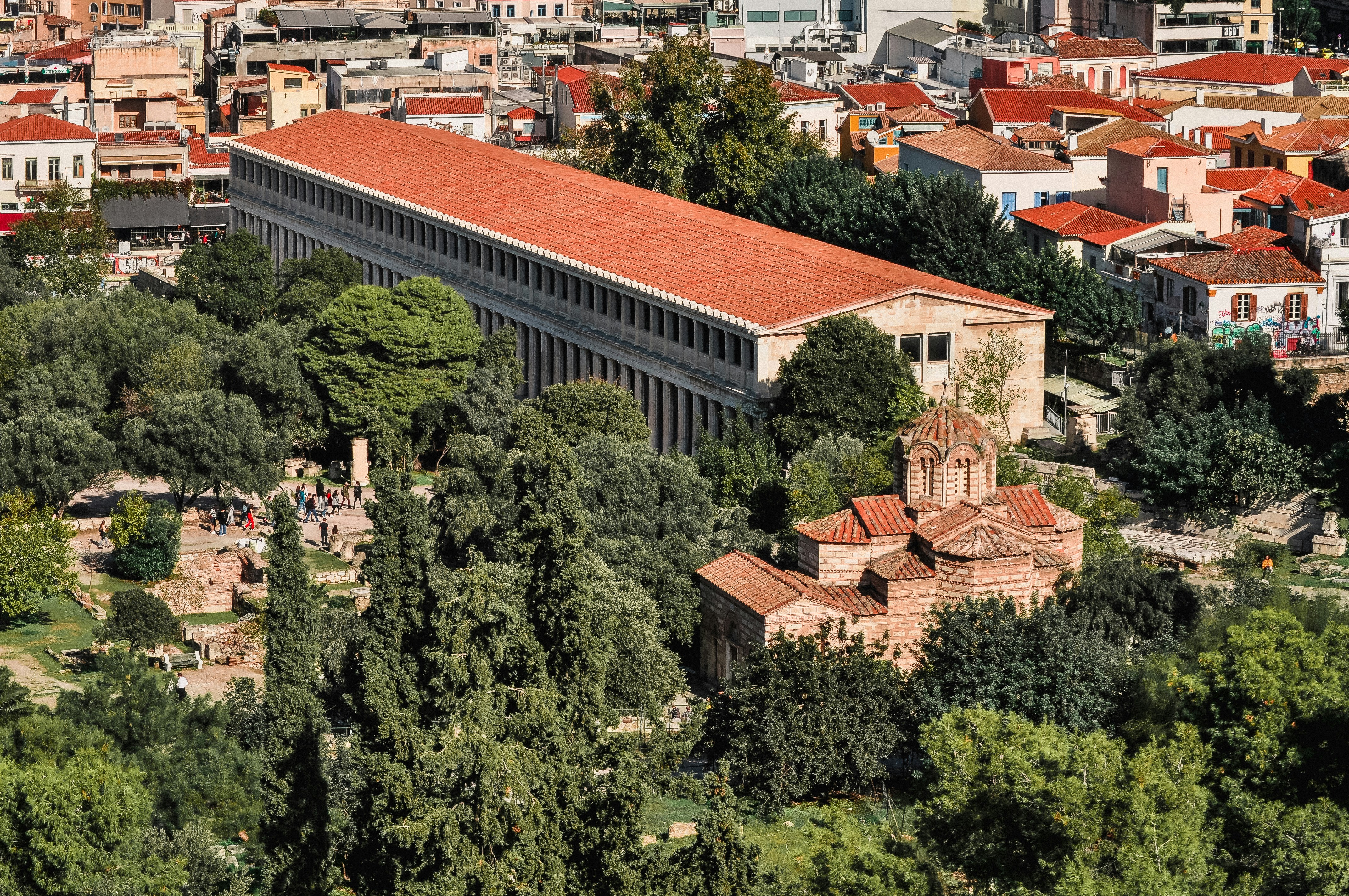
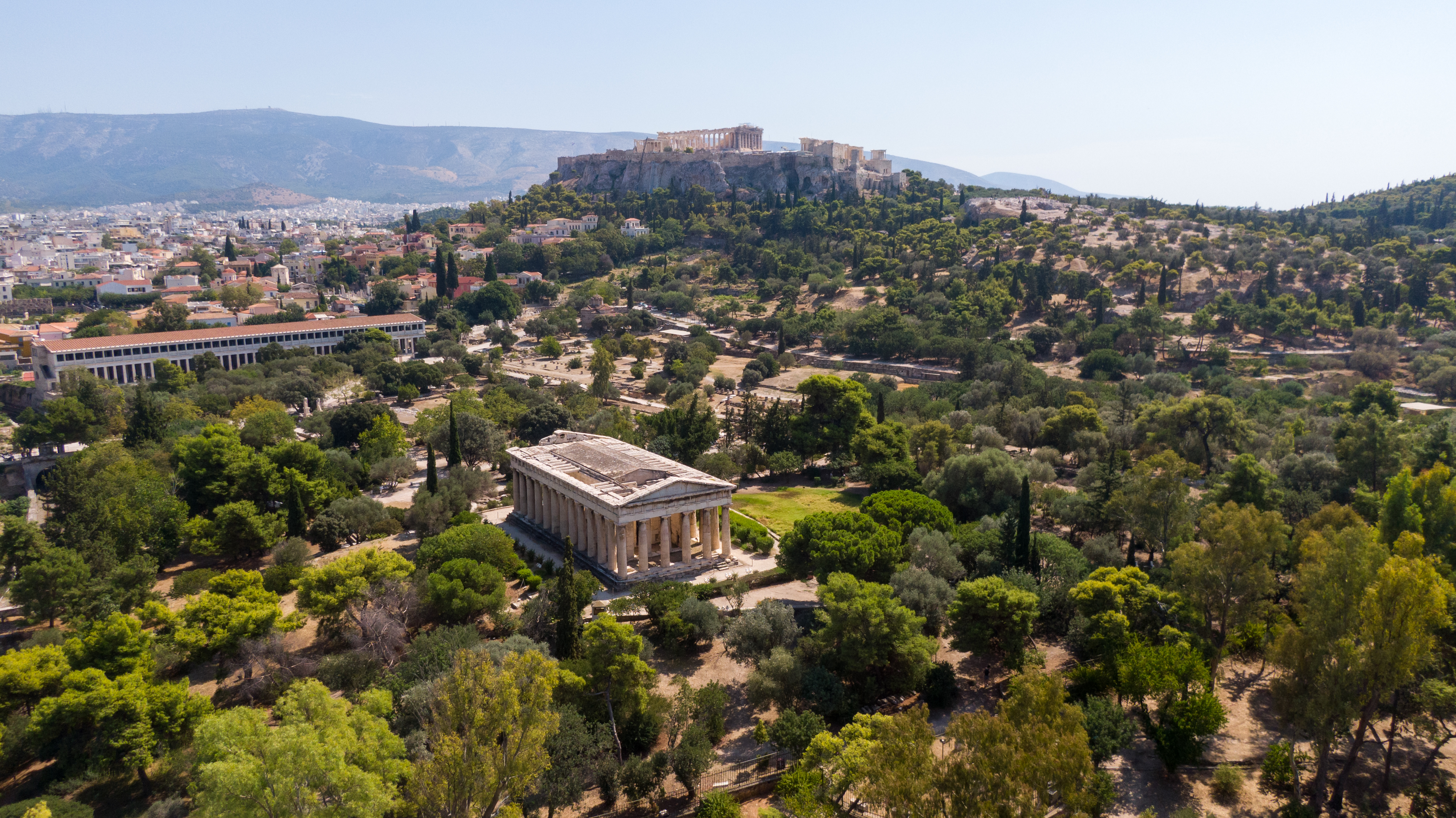
Comments